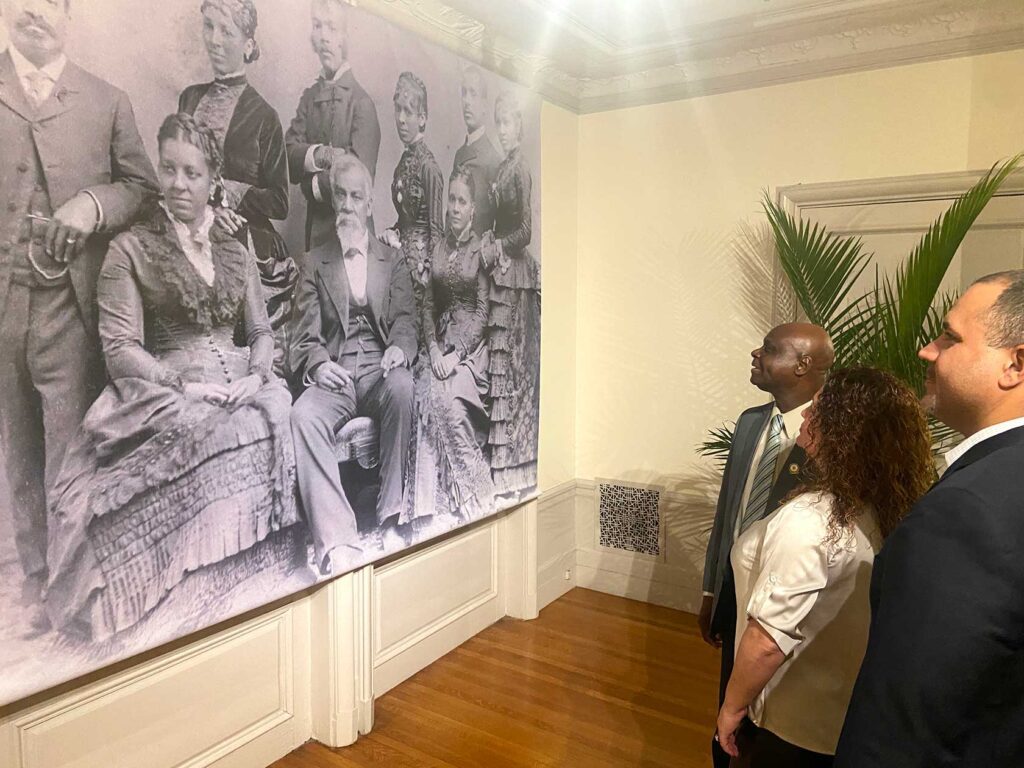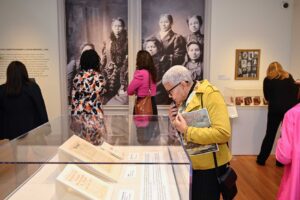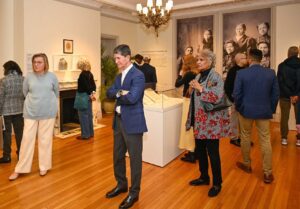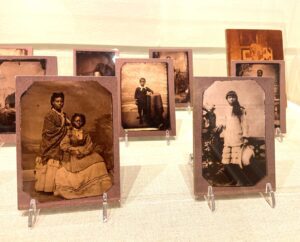
The Gilded Age, the late 19th century period of economic boom, conjures up names of wealthy white magnates such as the Vanderbilts and the Carnegies, who built transportation and steel empires. But the names of notable African heritage people of the same era, such as restaurateur Thomas George Downing and Rev. Mahlon Van Horne — the first man of color elected to the Rhode Island General Assembly — remain lesser known.
These names and more are the focal point of an exhibit in Newport, Rhode Island, that aims to bring this overlooked history to the forefront. Housed in the sprawling Rosecliff Mansion, “Gilded Age Newport in Color” tells the stories of African heritage families and the thriving communities they built through entrepreneurship and activism and is on display until June 30.

Dr. Kim Bullock examines a display at the “Gilded Age Newport in Color” exhibit at Rosecliff Mansion. PHOTO: DAVID HANSEN/COURTESY OF THE PRESERVATION SOCIETY OF NEWPORT COUNTY
“We feel that this story is an American story,” said Keith W. Stokes, consulting historian at the Rhode Island Black Heritage Society and vice president of 1696 Heritage Group. “You really can’t even begin to talk about the founding of America without the men, women and children who built America who were largely Indigenous and African enslaved people.”
Stokes’ late mother was one of the founding directors of the Rhode Island Black Heritage Society, the organization that partnered with the Preservation Society of Newport County to put on the exhibit. His wife, Theresa Guzmán Stokes, is the executive director of the Black Heritage Society. Together, Stokes and Guzmán Stokes researched African heritage people in Newport and, when offered a chance to tell the stories they and other Newporters had long talked about, they took it.
Many people don’t think of New England as a hub of Black history, Stokes said, when in fact the region was home to some of the earliest free Black churches, Masonic organizations, civic groups and schools. In fact, Stokes himself is a 9th generation Newporter and is a descendant of some of the families whose belongings are on display in the Rosecliff, including Rev. Van Horne.
On show are more than 150 objects dating back to the 18th century, including photographs, decorative arts, furniture, fine jewelry, and pamphlets from not only Newport but also Philadelphia and Boston. The collection also features the original publication of the Underground Railroad, which Stokes said has been a part of his family collection for years.
For her part, Guzmán Stokes is drawn to the section of the exhibit that tells the tale of the founding of the Colored Women’s Club, a group established by one Mary Dickerson that comprised disenfranchised women who advocated anti-lynching laws and child welfare, among other issues.
The main takeaway of the exhibit, Guzmán Stokes said, is that “African heritage people were involved in everything — the politics, the social activism — and that they took the opportunity that they saw presented before them of all the people that were using Newport as a summer resort to build their businesses around that.”
In the period after the Civil War, wealthy New Yorkers such as the Vanderbilts and the Oelrichses flocked to Newport during the summers, becoming household names in the city. Simultaneously, the professional class of African heritage people saw in these vacationers a chance to establish service industries, setting up transportation, dressmaking, medical and other businesses.
It’s a history that researchers and Newporters have talked about for years. African scholars and institutions, particularly historically Black colleges and universities, have long collected, interpreted, researched and presented African heritage history, Stokes said, but only since the creation of organizations like the Black Heritage Society nearly 50 years ago has it been shared with a wider public. Guzmán Stokes added that “the history that we see and that we’re taught, came about because someone was interested in it.”

Crowds move through one of the galleries at Rosecliff Mansion during opening night of “Gilded Age Newport in Color.” PHOTO: David Hansen/Courtesy of The Preservation Society of Newport County
Writings about people of color in the Gilded Age tend to employ terms such as the “Black elite” or “Black bourgeois,” which Stokes said is inaccurate. The African heritage men and women who built and maintained wealth did not keep it for themselves.
African heritage people reinvested their wealth into their communities to build Black churches, schools and political institutions. “And that’s what this exhibit represents,” Stokes said. “It’s what we call a new type of capitalism. It’s taking wealth that’s earned, and returning it to the community, not to the individual.”
The period on display mirrors the current moment, Guzmán Stokes said. The Gilded Age, like today, was a time of political upheaval headed towards a new era. For them, the turn of the century. For people today, the start of a new decade. This, for Guzmán Stokes, makes African heritage people of the Gilded Age an ideal guide for how best to navigate the political and socioeconomic landscape, which she said they did in a “dignified and professional” way.
“They really were concerned about how they were perceived by others. And so, they were very careful in how they did things,” she said. “Today, when we think of social activism, we think of people marching in the streets with signs and chanting. [African heritage people’s] social activism was different. It was quiet, thoughtful. They wrote a lot of pamphlets and papers, and they networked and talked to people to get things to change.”







